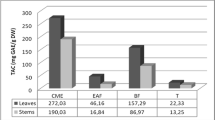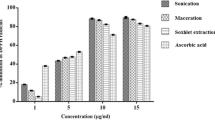Abstract
Detarium microcarpum is an African tree which is widely used as a folk medicine and food. A methanol extract from the leaves as well as its hexane, dichloromethane, ethyl acetate and n-butanol fractions were evaluated for their total phenolic content and radical scavenging activities. Additionally, a pre-column DPPH-HPLC assay was performed to screen and identify the compounds responsible for the antioxidant properties of the extract. Results indicated that the methanol extract contained a substantial amount of phenolic compounds with a value of 51.7 ± 0.2 mg gallic acid equivalent/g. It also exerted potent radical scavenging activities in both DPPH and ORAC assays, with respective values of 937 ± 16 and 2247 ± 63 μmol trolox equivalent/g. Its ethyl acetate and n-butanol fractions were shown to possess the highest TPC and radical scavenging activities. Pre-column DPPH-HPLC experiments led to the direct detection of five potential radical scavenging compounds which were identified as gallic acid, quercetin 3,7-O-dirhamnoside, myricetin 3-O-rhamnoside, quercetin 3-O-glucoside and quercetin 3-O-rhamnoside. All of them were confirmed to exert potent radical scavenging activities using common DPPH spectrophotometric assay. These findings revealed that D. microcarpum leaves possess potent antioxidant activity and could be recommended as a nutraceutical resource. Additionally, the identified bioactive compounds can be considered as appropriate markers for quality control.


Similar content being viewed by others
References
Akah PA, Nworu CS, Mbaoji FN, Nwabunike IA (2012) Genus Detarium: ethnomedicinal, phytochemical and pharmacological profile. Phytopharmacology 3:367–3753
Abreu PM, Martins ES, Kayser O, Bindseil KU, Siems K, Seemann A, Frevert J (1999) Antimicrobial, antitumor and antileishmania screening of medicinal plants from Guinea-Bissau. Phytomedicine 6:187–195
Bello MI, Raji LM, Modibbo AA (2013) Phytochemical screening and antimicrobial activity of the stem bark extracts of Detarium microcarpum (Guill. and Perr.). Asian J Biochem Pharm Res 3:1–5
Odoh U, Ezugwu C, Ezea C (2013) Antidiabetic and biochemical effect of the different fractions of methanol extract of Detarium microcarpum (Fabaceae) Guill and Perr stem bark on normal and alloxan induced diabetic rats. Planta Med 79(13), PN71
Lajide L, Escoubas P, Mizutani J (1995) Termite antifeedant activity in Detarium microcarpum. Phytochemistry 40:1101–1104
Abreu PM, Rosa VS, Araujo EM, Canda AB, Kayser O, Bindseil K-U, Siems K, Seemann A (1998) Phytochemical analysis and antimicrobial evaluation of Detarium microcarpum bark extracts. Pharm Pharmacol Lett 8:107–109
Cavin A-L, Hay A-E, Marston A, Stoeckli-Evans H, Scopelliti R, Diallo D, Hostettmann K (2006) Bioactive diterpenes from the fruits of Detarium microcarpum. J Nat Prod 69:768–773
Ebi G, Afieroho O (2011) Phytochemical and antimicrobial studies on Detarium microrcarpum Guill and Perr (Caesalpiniaceae) seeds coats. Afr J Biotechnol 11:457–462
Aquino R, Ciavatta ML, Tommasi N, de Simone F, de Pizza C (1991) Catechins from Detarium microcarpum. Fitoterapia 62:455
Pandey KB, Rizvi SI (2009) Plant polyphenols as dietary antioxidants in human health and disease. Oxid Med Cell Longev 2:270–278
Lobo V, Patil A, Phatak A, Chandra N (2010) Free radicals, antioxidants and functional foods: impact on human health. Pharmacogn Rev 4:118–126
Wang Z-J, Ohnaka K, Morita M, Toyomura K, Kono S, Ueki T, Tanaka M, Kakeji Y, Maehara Y, Okamura T, Ikejiri K, Futami K, Maekawa T, Yasunami Y, Takenaka K, Ichimiya H, Terasaka R (2013) Dietary polyphenols and colorectal cancer risk: the Fukuoka colorectal cancer study. World J Gastroenterol 19:2683–2690
Wang X, Ouyang YY, Liu J, Zhao G (2014) Flavonoid intake and risk of CVD: a systematic review and meta-analysis of prospective cohort studies. Br J Nutr 111:1–11
Bandonienė D, Murkovic M (2002) On-line HPLC-DPPH screening method for evaluation of radical scavenging phenols extracted from apples (Malus domestica L.). J Agric Food Chem 50:2482–2487
Koleva II, Niederländer HAG, van Beek TA (2000) An on-line HPLC method for detection of radical scavenging compounds in complex mixtures. Anal Chem 72:2323–2328
Tang D, Li H-J, Chen J, Guo CW, Li P (2008) Rapid and simple method for screening of natural antioxidants from Chinese herb Flos Lonicerae Japonicae by DPPH-HPLC-DAD-TOF/MS. J Sep Sci 31:3519–3526
Shimada T, Horikawa T, Ikeya Y, Matsuo H, Kinoshita K, Taguchi T, Ichinose K, Takahashi K, Aburada M (2011) Preventive effect of Kaempferia parviflora ethyl acetate extract and its major components polymethoxyflavonoid on metabolic diseases. Fitoterapia 82(8):1272–1278
Dubost N, Ou B, Beelman R (2007) Quantification of polyphenols and ergothioneine in cultivated mushrooms and correlation to total antioxidant capacity. Food Chem 105:727–735
Fraisse D, Felgines C, Texier O, Lamaison JL (2011) Caffeoyl derivatives: major antioxidant compounds of some wild herbs of the Asteraceae family. Food Nutr Sci 2(3):181–192
Gillespie KM, Chae JM, Ainsworth EA (2007) Rapid measurement of total antioxidant capacity in plants. Nat Protoc 2:867–870
Shi S, Ma Y, Zhang Y, Liu L, Liu Q, Peng M, Xiong X (2012) Systematic separation and purification of 18 antioxidants from Pueraria lobata flower using HSCCC target-guided by DPPH–HPLC experiment. Sep Purif Technol 89:225–233
Chandra A, Rana J, Li Y (2001) Separation, identification, quantification, and method validation of anthocyanins in botanical supplement raw materials by HPLC and HPLC-MS. J Agric Food Chem 49:3515–3521
Sosulski F, Krygier K, Hogge L (1982) Free, esterified, and insoluble-bound phenolic acids. 3. Composition of phenolic acids in cereal and potato flours. J Agric Food Chem 30:337–340
Zieliński H, Kozłowska H (2000) Antioxidant activity and total phenolics in selected cereal grains and their different morphological fractions. J Agric Food Chem 48:2008–2016
Rice-Evans CA, Miller NJ, Paganga G (1996) Structure-antioxidant activity relationships of flavonoids and phenolic acids. Free Radic Biol Med 20:933–956
Mabry TJ, Markham KR, Thomas MB (1970) The systematic identification of flavonoids. Springer, Berlin
Castro A, Cantrell CL, Hale AL, Duke SO (2010) Phytotoxic activity of flavonoids from Dicranostyles ampla. Nat Prod Commun 5:1233–1237
Lee M-K, Kim S-Y, Park J-H, Lee DG, Lee D-Y, Kim G-S, Kim Y-B, Han D-S, Lee C-H, Baek N-I (2013) Flavonoids from the leaves of Ailanthus altissima swingle and their antioxidant activity. J Appl Biol Chem 56:213–217
Hussein S, EL-Magly U, Tantawy M, Kawashty S, Saleh N (2017) Phenolics of selected species of Persicaria and Polygonum (Polygonaceae) in Egypt. Arab J Chem 10:76–81
Kim HJ, Kim B-G, Ahn J-H (2013) Regioselective synthesis of flavonoid bisglycosides using Escherichia coli harboring two glycosyltransferases. Appl Microbiol Biotechnol 97:5275–5282
Zhang YP, Shi SY, Xiong X, Chen XQ, Peng MJ (2012) Comparative evaluation of three methods based on high-performance liquid chromatography analysis combined with a 2,2′-diphenyl-1-picrylhydrazyl assay for the rapid screening of antioxidants from Pueraria lobata flowers. Anal Bioanal Chem 402:2965–2976
Author information
Authors and Affiliations
Corresponding author
Ethics declarations
Conflict of interest
The authors declare that they have no conflict of interest.
Compliance with ethics requirements
This article does not contain any studies with human or animal subjects.
Rights and permissions
About this article
Cite this article
Meda, N.R., Fraisse, D., Gnoula, C. et al. Characterization of antioxidants from Detarium microcarpum Guill. et Perr. leaves using HPLC-DAD coupled with pre-column DPPH assay. Eur Food Res Technol 243, 1659–1666 (2017). https://doi.org/10.1007/s00217-017-2873-7
Received:
Revised:
Accepted:
Published:
Issue Date:
DOI: https://doi.org/10.1007/s00217-017-2873-7




